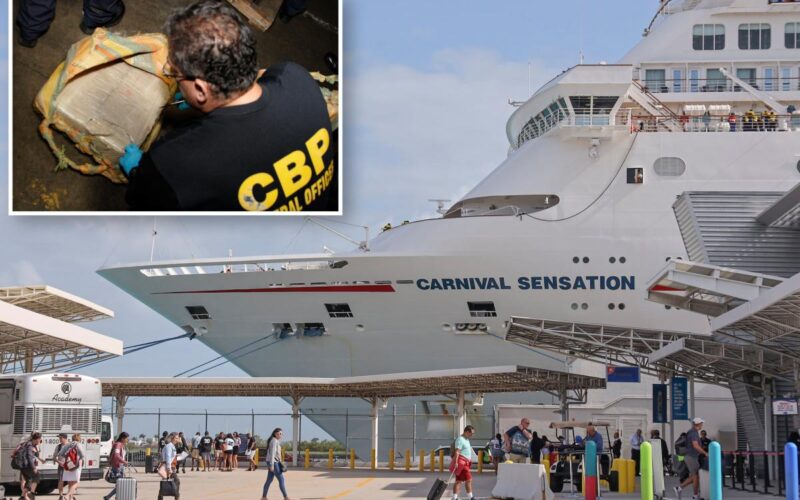The next drug vessel ferrying illegal narcotics to New York or South Florida isn’t a high-speed cigarette boat with twin engines — it might be a massive cruise ship with 19 decks and a water slide.
Because they sometimes make port in destinations with lax drug enforcement and carry thousands of passengers, cruise ships may unwittingly ferry legions of potential drug mules. But US Customs and Border agents are only conducting “minimal” security inspections, according to a troubling new Inspector General’s report.
“Overall, CBP conducted minimal secondary inspections during our site visits” to four Florida seaports, the IG investigators found.
Although Customs did check a passenger manifest to vet certain passengers, “we observed CBP using other methods to select passengers and crew disembarking cruise ships for secondary inspection less frequently,” probers found.
CBP wrongly “perceives the cruise ship environment to be low risk for trafficking illicit drugs and other contraband” into the US because of its own low record of seizures,” the investigators found.
The Sept. 29 audit, conducted in 2023 and 2024, obscures the precise number of returning passengers getting screened. But the report language makes clear it is not up to par.
It found that CBP’s own data was “incomplete, inaccurate, and unreliable,” calling into question its conclusions about smuggling risk. One CBP official even said the risk was low because cruises are round trip. “Why document something that does not have a risk?” one official told auditors.
Investigators “could not determine the targeting method that resulted in identifying a passenger or crewmember for secondary inspection” at the ports it studied: Jacksonville, Miami, and Port Everglades in Florida, along with Seattle, Washington, and Ketchikan, Alaska.
People who didn’t get an unusual hit on their passport due to something in their record mostly walked on through customs without a detailed look.
“They should have always been doing it. It shouldn’t be something new. Cruise ships have been around for decades,” said Sen. Mike Rounds (R-SD). “If they’re not doing that, it’s something that should be done, and I’m surprised that they’re not. Any time you’re coming back into the United States from another country there’s always a possibility” of smuggling, he said.
More than 1.5 million passengers flowed through the New York and New Jersey region in 2023, with 700,000 arriving at the Manhattan Cruise Terminal, 575,000 at Cape Liberty in Bayonne, and 259,999 at the Brooklyn Cruise Terminal in Red Hook, according to the report.
Surprisingly, the feds aren’t making much use of man’s best friend to counter the threat– as they do in airports and on AMTRAK.
“Canine units were rarely used due to limited availability as a shared resource,” auditors found, without explaining the reason they weren’t used more often.
The inspectors’ interest was first piqued after the San Juan field office conducted an assessment in 2023 and determined that Puerto Rico, along with St. Thomas, USVI, present “an ideal opportunity for illicit drug smuggling via cruise ships.”
The Miami field office followed suit in 2024 and found “inbound drug smuggling in the cruise environment remains a prevalent threat” in Florida. Offices found 4.75 kilograms of cocaine in two backpacks carried by a pair of sisters returning from a cruise to Jamaica, the Bahamas and Mexico.”
So auditors decided to evaluate just how thoroughly border inspectors looked over passengers and baggage upon their arrival from overseas voyages.
There have been some high profile busts on cruise ships in recent years that underline the risk – including four passengers detained in Bermuda for smuggling cannabis and the powerful synthetic tranquilizer Carfentanil, a man arrested for smuggling heroin and fentanyl in Texas while returning from a cruise to Mexico in April, and two US citizens busted trying to smuggle cocaine aboard a “Carnival Victory” cruise arriving in San Juan in 2011.
The audit comes as the US military has been targeting drug boats off the coast of Venezuela as part of President Trump’s campaign to stop the flow of deadly fentanyl into the US.
“CBP’s enforcement approach in the sea environment aligns with our operational priorities and available resources,” according to an agency spokesperson. “CBP continuously evaluates its processes to ensure the safety and security of the traveling public, interdict prohibited items, and facilitate lawful trade and travel,” the spokesperson said.
The agency said it “cannot provide specific information regarding enforcement operations, policies, or strategies that may compromise the integrity of its enforcement operations.” It wouldn’t confirm any changes, saying policies were determined by “mission requirements, risk assessments, and operational priorities.”








